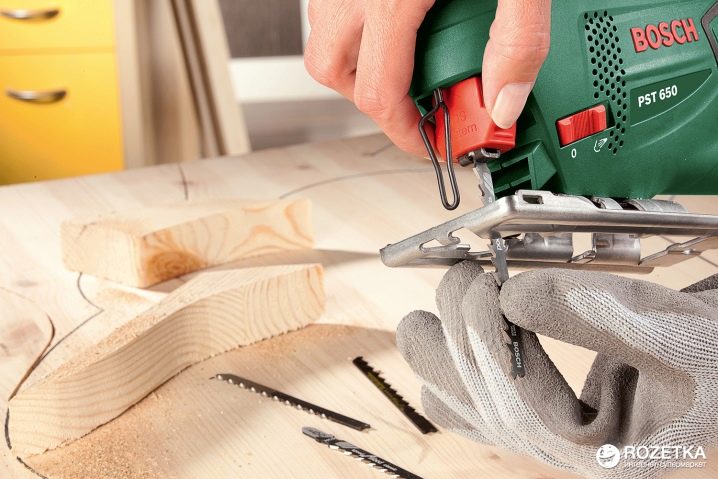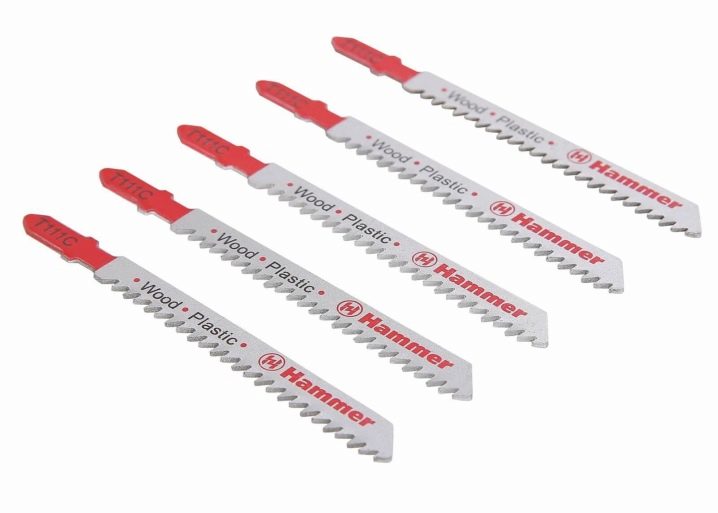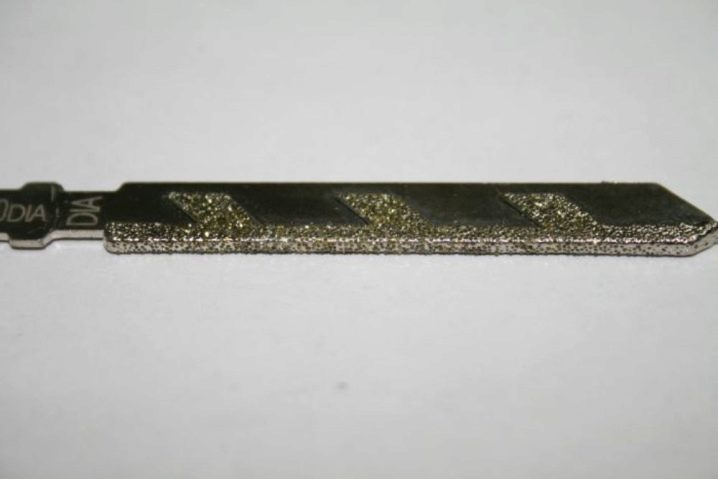Jigsaw saws: features and types

In the context of intermittent home repairs, there is a need for such a tool as a jigsaw. They can cut any material quickly and, with a little skill, evenly. It will help you cut round or square holes and cut a straight strip. With it, you can even create any piece of furniture yourself.

Such manipulations are done using special files that differ in their characteristics.
Marking
To choose the right file, you need to know the distinctive features of the product types. Labeling can help with this. These are certain alphanumeric abbreviations that indicate the properties of the nozzle and its quality characteristics.

Such designations are necessary primarily for people who are not professionally engaged in repairs and cannot determine the purpose of a particular nozzle due to external characteristics.
The main part of the information that is needed for the correct choice is located on the tail of the file. It includes letters and numbers. Each of the symbols carries specific information.
The initial letter characterizes the type of tail, which can be:
- T - figurative form;
- U - figurative;
- M - the mount is only suitable for the Makita brand;
- Fein standard.

The second sign indicates the length of the canvas, which is produced:
- 1 - up to 7.5 cm long;
- 2 - sizes from 7.5 cm to 9 cm;
- 3 - from 9 cm to 15 cm long;
- 7 - with a maximum length over 15 cm.

The following letter indicates the dimension of the saw teeth. They can be: A (small), B (medium), C or D (large).
The fourth letter helps you to find out the most important information about the cutting blade. This could be:
- F - a very strong alloy of two metals is used for the manufacture;
- P - indicates a precise cut;
- O - indicates a narrow back of the canvas;
- X - describes the progressive pitch of the teeth;
- R - when the teeth have a reverse (reverse) direction.

To find out the material for which the file is intended for cutting, you need to pay attention to the shank color.
So, a gray tip indicates the possibility of cutting wood, a blue one - any metal structures, and a blade with a red tip can be used to cut a plastic surface.

In addition, the abbreviation on the neck indicates the type of blade steel.
Distinguish:
- HM - hard metal alloys;
- HCS (CV) - steel products with a high carbon content;
- HSS - steel that cuts quickly;
- CV - chrome and vanadium steel;
- BM (BiM) - a combination of carbide and high speed steel.
The last combination is the strongest and most durable.

There is one more mark that is affixed directly to the blade. These are English words for any important quality of the blade that must be taken into account during use.
This could be:
- indication of the ability to process soft materials - Wood;
- metal cutting - Metall;
- use for processing hardwood and PVC materials - Hardwood;
- work on stainless coatings - Inox;
- work with fiberglass - Fiber, Plaster;
- the possibility of sawing aluminum surfaces - Alu;
- cutting rubber and carpets - Soft-material;
- processing of polycarbonate products - Acrylic.

There are also versatile blades that can be used when cutting any material.However, it will be difficult to cut out various shapes with such a blade, therefore, a set of a large number of files is required for professional activities.

Materials (edit)
Generally speaking, all canvases are made from metal alloys. To cut softer materials, they simply release metal blades. If it is necessary to cut the metal, then the technology of fusion of several components is used to increase the strength of the product.

There are materials that are super strong. These include ceramic tiles, porcelain stoneware and granite, decorative stone. For their accurate and high-quality cutting, non-standard solutions are needed, since they are very durable and easily pricked. That's why jigsaw blades are produced with special spraying or soldering from hard alloys.

So, the coating of the cutting edge is often diamond. Its main indicator is graininess, which can be high or low. The absence of chips and cracks along the cut, as well as the speed of the process itself, directly depends on the level of graininess. The higher it is, the easier it is to make a high-quality and accurate cut.
There are some general rules for all types of materials. A straight cut can be made with a wide blade. If it is supposed to perform curly cutting, then it is better to choose the canvas a little narrower.
However, cutting with an electric jigsaw of hard materials (porcelain stoneware), in any case, the process is long. Therefore, this device justifies its use only for curly cutting of parts.

Appointment
These products are also distinguished by the material that they can cut.
Canvases are produced by:
- for plastic;
- wood;
- metal;
- ceramics;
- concrete;
- stone;
- cardboard (chipboard);
- universal.



Modern jigsaw files have a large number of parameters by which they can be distinguished. However, these markings mean practically nothing to ordinary users. The simplest and most understandable is the difference in purpose. That is, the difference between canvases in materials that can be cut with them.
When working with wood, they use blades made of steel grades: BM, CV and HCS... As for chipboard, to get a neat cut without chips, the size of the saw teeth should be A or B. Large sizes of type D help to make straight rough cuts in thick wood and chipboard or fiberboard. An example is the T344C blade.

There is also a file modification for cutting cardboard. It has a rather unusual wavy blade without teeth. When working, the blade smoothly divides the material into parts.
This option is also suitable for other soft materials:
- rubber;
- foam;
- carpet.
Further, it must be said about the decorative materials that are most often used for interior decoration of premises - these are laminate and coated tiles.
The most suitable for them is the blade marked T101BR. The middle teeth of this blade help prevent material damage in areas along the cut.

For shape cutting of the above materials, it is best to choose a small, narrow blade with medium teeth (T101BO)... The small size makes it easy to maneuver the tool.

When sawing metal structures, you need to know that steel files BM and HSS with wave-like teeth give a clearer and more even cut. Metal sheets that are up to 0.3 cm thick can be cut with T118A, up to 0.6 cm with T118B. When the metal is very thin (up to 0.15 cm), then the blade is taken with microscopic teeth, with the designation T118G.

If we are talking about a metal profile or pipes up to 3 mm, which is important when repairing water supply and hanging towels in the bathroom, then use the T318A canvas. Its length can be up to 15 cm.

When it comes to PVC, they use both special files for processing plastic materials, and ordinary products for wood or metal.A smooth cut will be obtained when using a blade with large teeth, since the crumb from the plastic heated by friction can fill the working part of the file. The speed of the jigsaw itself is best kept to a minimum. The steel grade of the blade can be either CV or HCS or HSS.
Thicker surfaces are easier to cut with a medium-toothed, short-cut blade - T101BF.
Plexiglass is cut well with a fine-toothed T101A metal file.

Ceramics are also an important element of the renovation. They have a very fragile structure, so the use of a toothed file is not possible. In such cases, a special blade is needed, which, instead of teeth, has an abrasive spraying of diamond chips.

Tungsten carbide tipped devices can also be used, but they are only suitable for thin wall tiles. Cutting them into tiles will be ineffective. In the marking of such a file, the letters HM must be present.
If necessary (in the absence of a grinder), concrete coatings, blocks or stone can be cut with a jigsaw. The blade for such cutting has a double marking: Gasbeton / Kunststoffe and Fiber / plastic HM / CT-31137. Some experts say that a metal file is also suitable for such work, however, the blade does not last long.
And finally, a universal blade, which is convenient for making not only rough cuts of wooden surfaces up to 5 cm in thickness, but also for sawing steel, plastic and soft metals.
Dimensions (edit)
The marking of the dimensions of the jigsaw blades, given above, allows us to draw conclusions about the types of blades in size. Files can be small, medium and large. In this case, the dimension describes the length. In this case, the C marking simply means a long blade, and D - indicates the maximum length of the file.

It is believed that the longer the blade, the better it cuts in a straight line. Medium and short options are suitable for curly cutting.
But there are also features of canvases of different widths. This parameter determines the amount by which the blade deviates from the perpendicular during cutting. The wider the file, the more deviation it gives.... Therefore, wide versions of the jigsaw tip are used for straight cutting, and thin ones for curly cutting. In addition, the peculiarities of the tip of the blade often do not allow it to be fixed in the self-clamping mechanism of the tool.
Ponytail shape
According to this indicator, you can determine which brand of technology and the type of clamping mechanism of an electric jigsaw the file is suitable for.
The T-shaped tail was invented by Bosch engineers, so this canvas is suitable for this brand of equipment. Later, other companies also began to use this form.

The U-shaped shank is the know-how of American craftsmen. In the equipment that is sold in our market, such a shank is suitable for old models of jigsaws, as well as for units with clamping shoe and screw types.
The ends of the saw blade like Makita and Bosch fit the equipment of the same manufacturers, respectively.

Geometric parameters of teeth
The width of the cut, its accuracy, as well as the speed of work directly depend on the shape and location of the teeth.
The geometry of the teeth is:
- diluted milled;
- wave-like milled;
- conical grinding;
- diluted polished.
The milled teeth in both directions, in turn, help the blade to avoid overheating. It is convenient to cut non-ferrous metals with such files.
In wavy milling, the teeth in groups are bred smoothly, with a slightly greater inclination of each subsequent tooth, also alternately to the right and left. They are used for clean cuts (cuts with clean-cut, beveled edges).

Tapered blades also provide clean cuts on plastic, wood, laminate.
Saws with diluted grinding of teeth are used when it is necessary to carry out a rough cut of materials such as fiberboard, chipboard and soft wood.


How to choose?
On the modern market, there is a large selection of jigsaw files. The canvases vary dramatically in both price and quality. Given the unsafe use of low quality files, it is advisable to purchase proven products. This can be selected according to the popularity of the brand. The policy of such companies is to maintain a positive reputation for products, so they only release reliable products on the market.
The best manufacturers of accessories for jigsaws are Makita, Bosch, and Matabo.... The best option for combining pricing and quality is the set of Bosch brand blades. Their canvases are very easy to use and have a high level of performance. Sadly, but the products of this manufacturer are the most often counterfeited, so it is best to buy files in specialized hardware stores, which can provide quality certificates for their goods.
However, counterfeit components can also be distinguished visually. For example, when there is corrosion or other damage on the product, there is no doubt that the canvas is fake... Also, counterfeit can be identified along the edges of the product. The saws released "in the basements" have a rounded end on one side... Such a defect occurs due to the process of stamping sheet metal sheets. Real products will have the same rectangular ends on both sides.



And, of course, you should pay attention to the quality of the labeled labels. If they are indistinctly executed or blurred due to the use of cheap paint, then a fake is obvious.
Subtleties of operation
In order for the canvas to serve as long as possible, it must be used and stored correctly. First of all, if the work is performed by a non-specialist, it is necessary to familiarize yourself with the instructions for clamping the blade in a jigsaw, since a wide variety of manufacturers has led to the presence of non-standard designs of locking mechanisms.

Sharpening is also important to maintain working condition. You can determine the need for such manipulation by the deviation of the cutting angle from the guide (from 90 degrees to 45).
If the saw teeth are dull, they must be sharpened with a diamond file if the teeth are small, and with a medium or diamond file if they are large or medium in size.

How to choose files for a jigsaw, you will learn from the video below.













The comment was sent successfully.